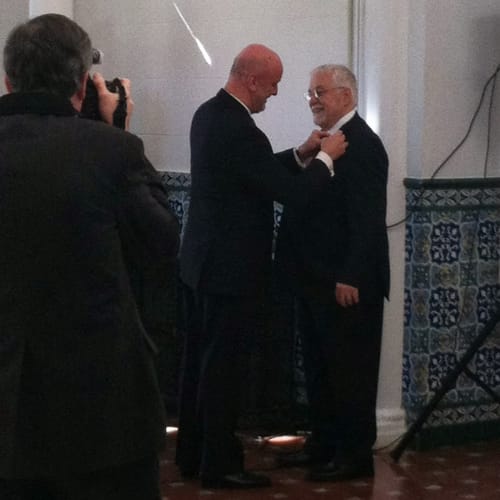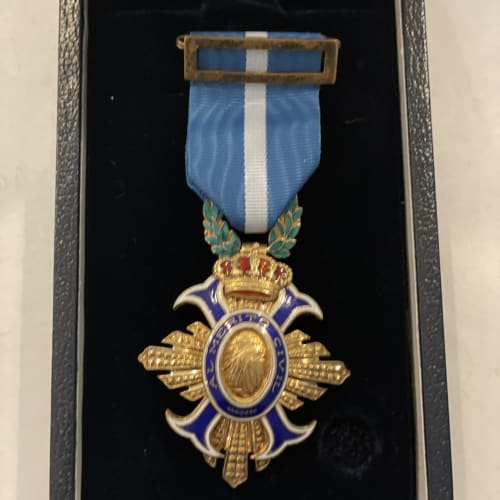Three Kings Sale - Up to 40% Off! Shop Sale
Sharing My Love for the People of Spain
Don Harris | November 2012




Last month I received one of the most meaningful recognitions of my life. My family and I were at the Spanish Embassy in Washington, DC where the Ambassador presented me with the Cross of Civil Merit, awarded by the King of Spain for "extraordinary services promoting the people, culture and foods of Spain here in the United States."
What made it especially satisfying was that it confirms and recognizes the special love I have long held for the Spanish people and their way of life. Because my life has been made so much richer by doing so, I have encouraged my friends in America to get to meet the people of Spain, if not in person, then at least through the foods they enjoy.
My October reflection, Letters from Valencia, explained how, as a child, I began to perceive something of the Spanish culture through the emotional and mystical paintings of El Greco, and the many faces of Spaniards he portrayed. Fifteen years later, in Toledo, when I mingled with the people of El Greco’s “hometown,” my perception was confirmed. For me, to experience the warmth and acceptance of another person is what trumps all other factors, and this I found among the Spanish people.
It all started back in March 1965 when my ship, the USS Damato (DD871) was tied up along the pier so that the ship’s company might enjoy the festivities surrounding Las Fallas – an amazing extravaganza of food, bonfires and firecrackers.
I was a new young chaplain on board my first Navy ship, and at the end of the day’s work, I would walk the streets along the waterfront of Valencia, hoping to meet some of the local people. I recently retrieved some old letters written to my wife Ruth 45 years ago which described my first encounters with young Spaniards. I would like to share parts of them with you. I wrote to Ruth:
I met some really great teenage kids at the game room/jukebox-type place. We got to be really good friends in the few days we were together, and I got to learn a lot about the people. Juan is 19; he works in construction during the day, goes to art school at night. He took me to his school and introduced me to his teachers. The subjects included sculpture, woodcarving, charcoal, oil painting, stained-glass window making, commercial art and metalwork.
A little 12-year-old took me to a store that concentrates on handmade religious art and I got a really swinging {sic} abstract crucifix made by a Catalan. The other boy is 18, works as a chauffeur during the day, and studies mechanical drawing and architecture at night. He also is a fine kid...
These encounters made a lasting impression on me. First, I felt so hopeful seeing the resilience of the Spanish youth. 1965 was still hard times for many people in Spain, both emotionally and economically, as their families were trying to put their lives back together after a hateful civil war. There were many older women dressed in black, mourning losses in their families. Yet these young people were industrious and optimistic. An 18-year-old boy working as a chauffeur found time to study architecture at night; the 19-year-old followed up a hard day’s work in the construction industry by enrolling in art school to do what he loved.
More than that, the Spanish young people were genuinely warm and welcoming toward me, a perfect stranger. I especially liked the little boy who took me to a beautiful store full of handmade sculptures, undoubtedly made locally. I still display a cross from that store on my wall at home. (I do not know in my more dignified years that I would call it "a swinging cross," but it is dramatic in its simple line.) I truly enjoyed my interactions with this group of young people.
Later in the evening, each night I moved on to a fine little hideaway called Casa Angel, which is a small place like Giovanni’s by the North Gate in Berkeley. There were a lot of young people from their early to late 20s there: an engineer who had lived in New York for a year, a French girl who was sort of tired of France who came down to learn the language, another French girl with about the same motivation, many Spanish girls who work in the various shops around town, a couple of art students.
(There were) many Spanish men from various schools and jobs including a man named Francisco who was an artisan during the day and loved to play the guitar all night long – he played Spanish, Mexican, flamenco, Andalucían, American and French songs with equal facility. {They} sat around singing songs and clapping strangely complicated Spanish rhythms. I understand that they are so complicated because they are Moorish rather than African-based rhythms.
After meeting these young Valencians, I returned to my ship and spread the word that there were young Spaniards (including señoritas) about the same age as the crew whom they would enjoy meeting at the tapas bar. It was a much better alternative than hanging out in some sailor bar. Members of the crew came with me – a few more each night – and got a true and lasting flavor of Valencia and her people. It was the first step in a lifetime of, as the award says, "Promoting the people, culture and foods of Spain."
Each evening in Valencia, I would take a half a dozen sailors with me down to this rock and roll place where they would end up meeting the Spanish teenagers and playing games with them. It was a lot of fun and educated both the groups. I then would take the sailors over to Casa Angel, where they certainly enjoyed the good music and conversation.
As the evening wore on, sometimes there would be gypsies stopping by, inevitably breaking into mournful song. Casa Angel was a friendly neighborhood bar. You might be amused by my first description of tapas:
During the evening before dinner they munch on hors d’ oeuvres or antipasto. The dishes are shrimp (small), snails, lobster, a dry salt fish, olives stuffed with anchovies, pimentos, almonds etc., squid cooked in their own ink, sausages, potato salad, oysters, tiny clams, American peanuts which we call in America Spanish peanuts, toasted almonds, etc.
By the way, an interesting tasty dish I ate as a hors d'oeuvres is called an angelito (gambas al ajillo). Maybe we can try it in Norfolk with variation.
They bake it in a small cast-iron dish about the size of the exterior measurements of the wooden ashtray at home; a mixture of small shrimp garnished with a piece of onion (sliver) a couple of pieces of sausage (pepperoni type), ample garlic and olive oil (could use butter, but they do not because it costs so much).
It is served sizzling hot with a hard roll. One tears off pieces of hard roll and sops up the liquid. By the time the juices are absorbed the bread has run out and the shrimp is cool enough to eat. I forgot a most important ingredient: cayenne pepper – this is one of their few peppery dishes.
So there you have it - an art book, an awesome city and introducing American sailors to Spanish youth at a tapas bar. From those experiences my appreciation of Spain was born. As the years passed, I have met many fine people throughout Spain. I have concluded that the treasure of Spain is the family and the way they cherish their children, surrounding them with love. Nearly as important is the way family members and friends meet around the table to enjoy good food and their relationships with one another.
I am grateful that my family and I are able to work with these good people, to honor their artisan traditions through La Tienda, and to spread the word far and wide about the beauty of Spain and her culture. ¡Que viva la familia Española!
My best wishes to your family and those whom you love.
Don
P.S. Some of you may enjoy reading my book The Heart of Spain: Families and Food. It is filled with pictures of people and places I have met and seen through the years.

